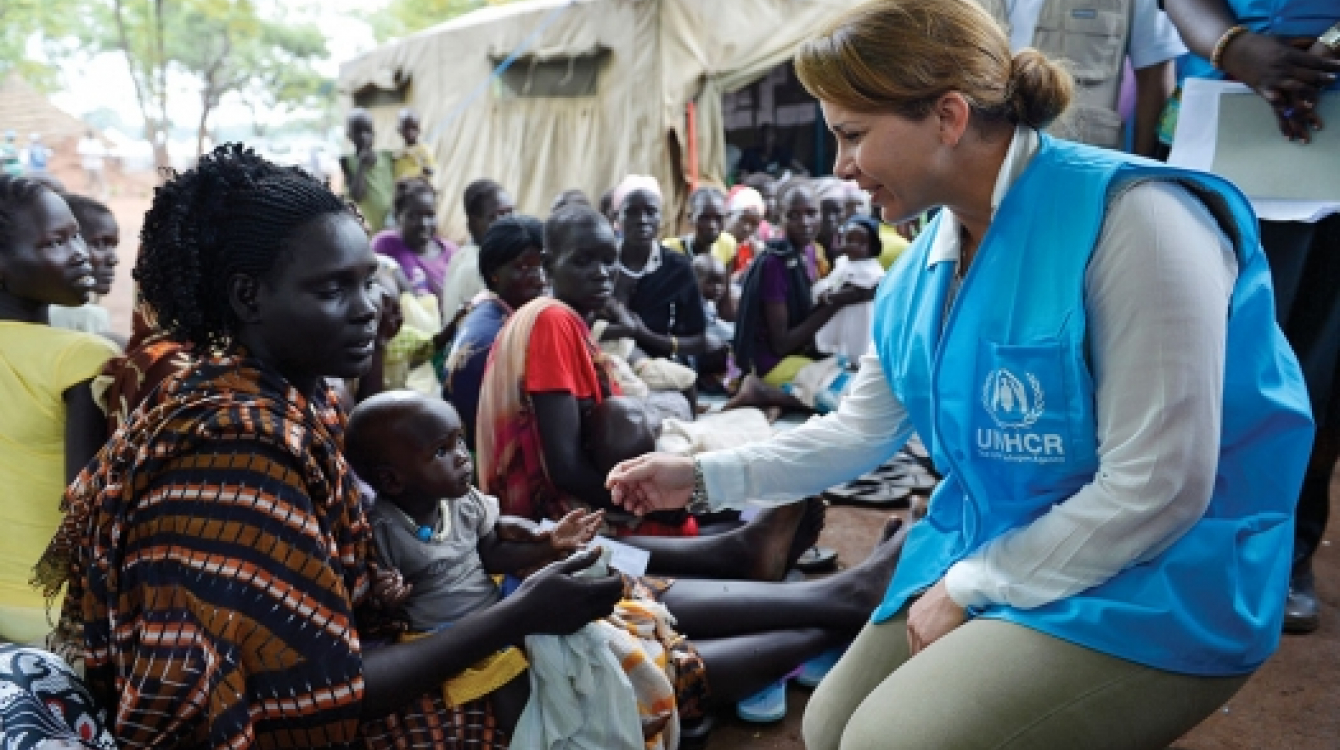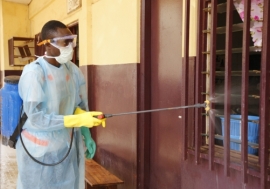Refugees turn to Ethiopia for safety and asylum
Refugees turn to Ethiopia for safety and asylum
As a 17-year-old boy, James Gaw Tot fled war in South Sudan to the safety of Ethiopia. Little did he know he would call this country his home for the next 23 years.
Today, still a refugee, Tot lives in a camp with his refugee wife and their seven children. He longs for home.
“I want to return home, but how can I?” he asks, gazing out at the Pugnido Refugee Camp in western Ethiopia. “There is still insecurity in my country. Before this, the war with the Arabs was about the struggle for independence. South Sudan is now independent but the fighting continues.” In the camp, Tot works as a social worker, sensitizing fellow refugees on HIV prevention.
Tot is among the more than 665,000 refugees currently living in Ethiopia, making it the largest refugee-hosting country in Africa, passing Kenya in July 2014. Most of the refugees come from Eritrea, Somalia, South Sudan and Sudan.
In mid-December 2013, thousands of South Sudanese were uprooted from their country when President Salva Kiir accused his ousted deputy, Riek Machar, of planning a coup. The fighting in the world’s youngest nation soon took a tribal dimension between the Dinka ethnic group of President Kiir and Mr. Machar’s Nuer ethnic group, triggering a cycle of retaliatory massacres across the country.
“My parents and my wife’s parents were fleeing together. They were killed,” said 27-year-old Biel Jock. He fled from Nyirol in South Sudan’s Jonglei State with five nephews aged between nine and 14 years. They became his dependents after their parents were either killed in South Sudan’s conflict or died from natural causes. Mr. Jock and his family crossed into Ethiopia sometime in 2014 almost empty handed after walking 16 days in the jungle feeding on wild fruits and drinking any water they could find along the way.
Resolve conflicts to end crises
“We are witnessing a quantum leap in forced displacement in the world,” said António Guterres, the UN High Commissioner for Refugees (UNHCR), as figures for 2013 showed a total of 51.2 million refugees, asylum seekers and internally displaced people. It is the highest level of displacement since the Second World War. The spike has been driven mainly by the war in Syria. Conflicts in the Central African Republic and South Sudan also contributed to the skyrocketing numbers.
According to Mr. Guterres, humanitarian organisations can only mitigate the impact of conflict on ordinary people. “There is no humanitarian solution. The solution is political and the solution is to solve the conflicts that generate these dramatic levels of displacement.”
Currently, there are more than three million refugees in Africa, 12.5 million internally displaced people and another 700,000 stateless people, according to UNHCR.
Dire situation in the Horn of Africa
Sharing borders with Somalia, South Sudan, Sudan and Eritrea which are grappling with conflicts, Ethiopia has been hosting refugees since the 1990s. In 2011, the country had only eight refugee camps with some 90,000 refugees. But as of June 2014, the number had spiked upwards to 23 camps. South Sudanese make up the largest number of refugees in Ethiopia at 253,030, followed by Somalis (245,326), Eritreans (126,363), Sudanese (35,870) and other nationalities accounting for almost 5,300.
While the Somali civil war has dragged on for over two decades, the ongoing conflict in Sudan between the Sudanese government and Sudan People’s Liberation Movement (SPLM)–North, continues to force thousands of Sudanese to flee into Ethiopia.
Ato Ayalew Aweke, the deputy director of Ethiopia’s Administration for Refugee and Returnee Affairs, says there were more than 450,000 South Sudanese refugees in Ethiopia in the late 1980s and early 1990s. Most of the refugees were repatriated with about 20,000 remaining by 2013.
“In the Horn of Africa, Ethiopia is a very peaceful and stable country. We have eight camps for Somali refugees alone. From October to December 2014, we experienced an increase in the number of Eritreans coming to seek refuge in Ethiopia,” says Mr. Aweke.
“When you see the figures of refugees, for instance, which went up from 90,000 to over 600,000 in two or three years, the situation clearly demonstrates the severity of the displacement and suffering in the countries around the region,” says the UNHCR Deputy Representative in Ethiopia, Bornwell Kantande. “Along the way, for the past two decades until now, not a single day has gone by without refugees in Ethiopia. No single day has passed without Ethiopia providing its support to refugees,” he says.
Funding gap
Funding to support refugees in Ethiopia remains a challenge with confirmed contributions so far standing at 12%.
In spite of the assistance from donors, the refugees continue to strain local resources such as water, food, as well as educational and health facilities. These facilities invariably require expansion or improvement, the lack of which has the tendency to fuel tension. To ensure that refugees and locals live peacefully together, the UN refugee agency has various projects in host communities.
“We need more international assistance to provide the basic needs for the refugees such as shelter, food, water, sanitation, education and health,” says Mr. Aweke.
The refugees are involved in various livelihood activities, including small-scale animal husbandry and other agricultural projects. UNHCR provides them with business grants and training on cooperative development and business management. The agency is also piloting an agricultural project focusing on improving the livelihoods of more than 200,000 Somali refugees in the Dollo Ado area.
In the Jijiga area where there are three camps hosting more than 40,000 Somali refugees, UNHCR engages the refugees and host communities in self-reliance activities under its Development Assistance for Refugees project.
Early this year, for example, a livelihood and food security project was launched in Kule refugee camp in the Gambella region. The project started with training in business and income-generating activities for more than 800 refugees, who went on to develop their own business plans and form business groups. At the launch of the project, the refugees received seed money to start businesses, and will continue to receive more training.
Again, refugees with skills also serve as teachers, nurses, interpreters, or social workers with various organizations within the camps.
New challenges are, however, bound to come along the way. For example, during the South Sudanese refugee emergency last year, as humanitarians were working around the clock to provide assistance, an unprecedented heavy downpour in August 2014 and the overflowing Baro River banks led to the flooding of Leitchuor and Nip Nip refugee camps, two of the four new camps established to host new arrivals.
“It was a very difficult situation. We had an emergency with waves of people crossing over the border, and then the flooding created another emergency,” says UNHCR Representative in Ethiopia Valentin Tapsoba. He commended Ethiopia for sharing its meagre resources with the refugees.
In response to the crisis, humanitarian personnel used boats and a UNHCR-hired helicopter to transport personnel, refugees and some logistics. A mass cholera vaccination exercise was also undertaken in the flood-affected camps.
“Our priority right now is to relocate some 50,000 South Sudanese refugees from the two camps that were flooded last year before the next rainy season in a couple of months,” says Angele Djohossou, UNHCR’s head of the Gambella sub-office, which is in western Ethiopia and hosts more than 250,000 South Sudanese refugees. Refugees from Leitchuor Camp will be relocated to a new site that the local authorities have allocated while those from Nip Nip Camp will be relocated to Pugnido Refugee Camp, which currently hosts about 55,000 South Sudanese refugees. “We will continue to search for new sites for the establishment of camps as new arrivals continue,” Ms. Djohossou added.





















